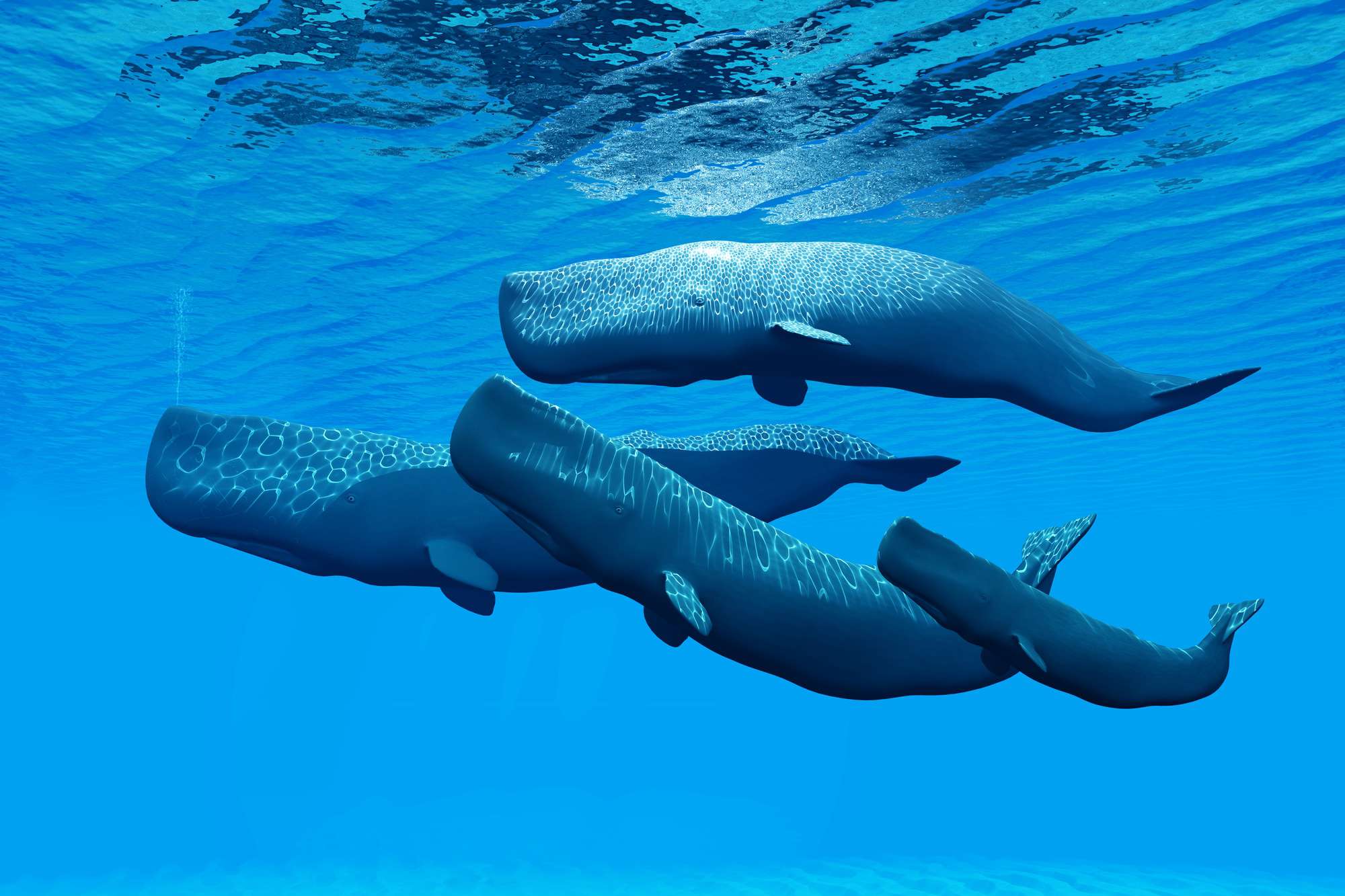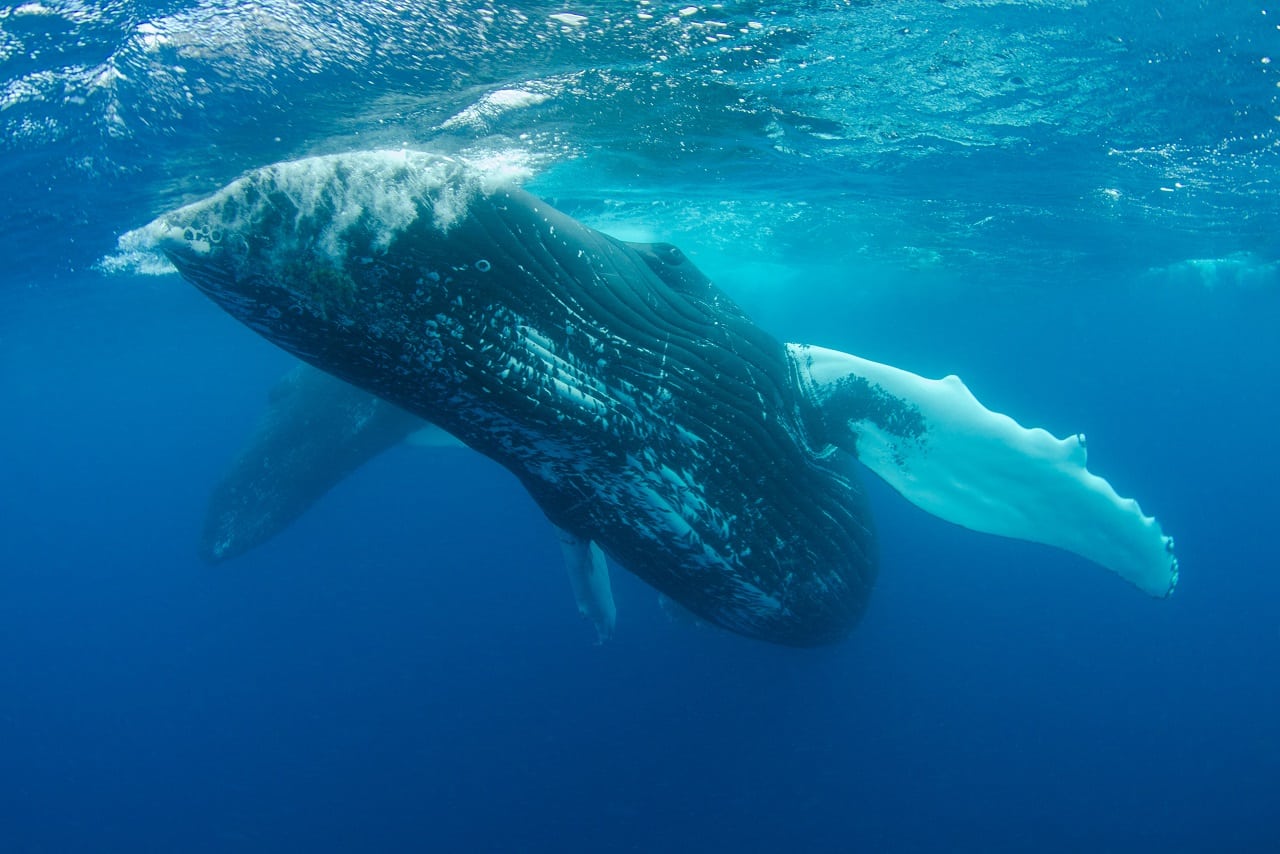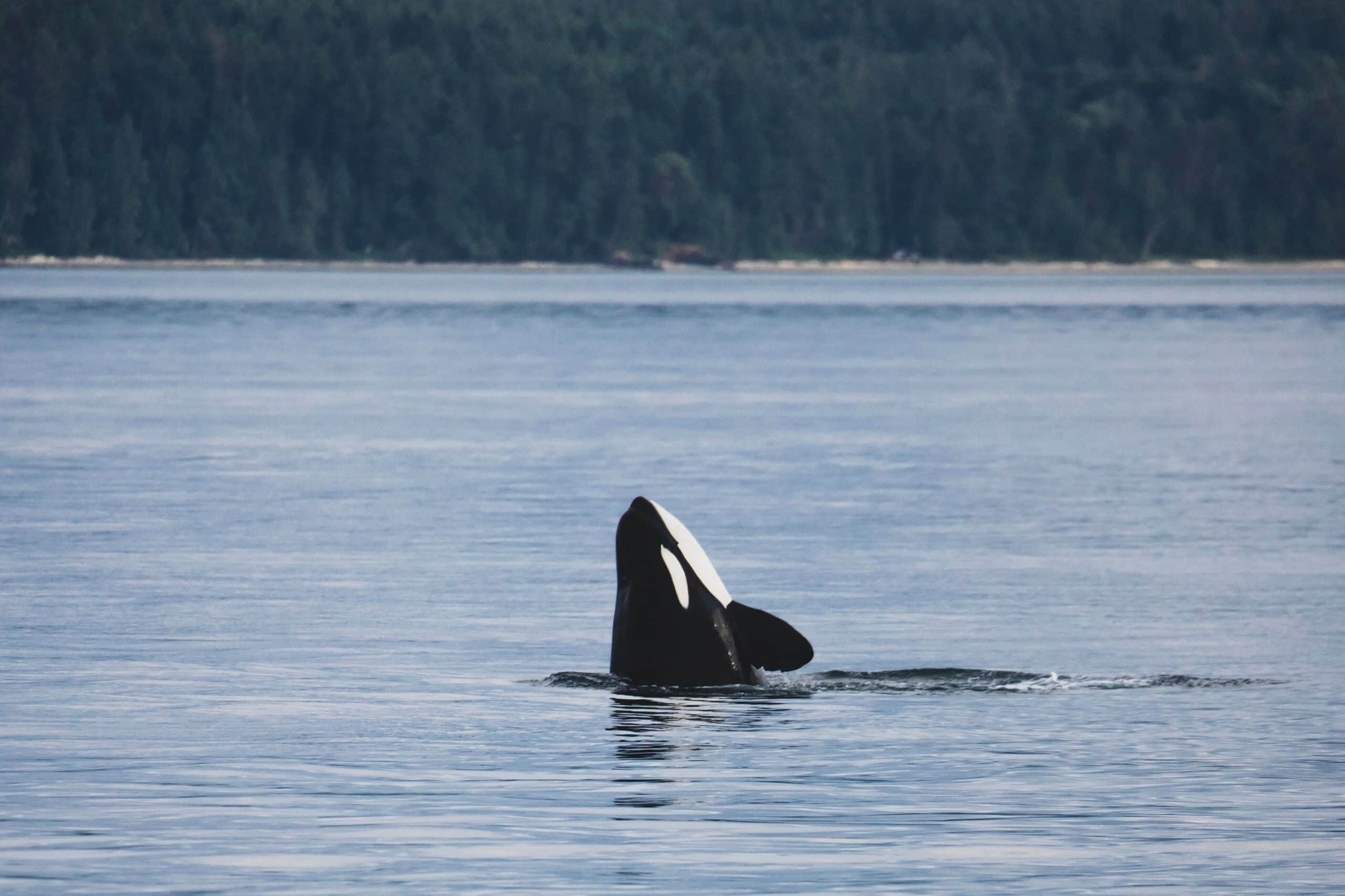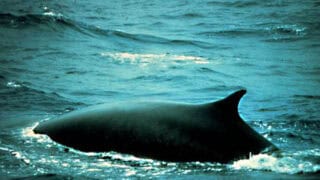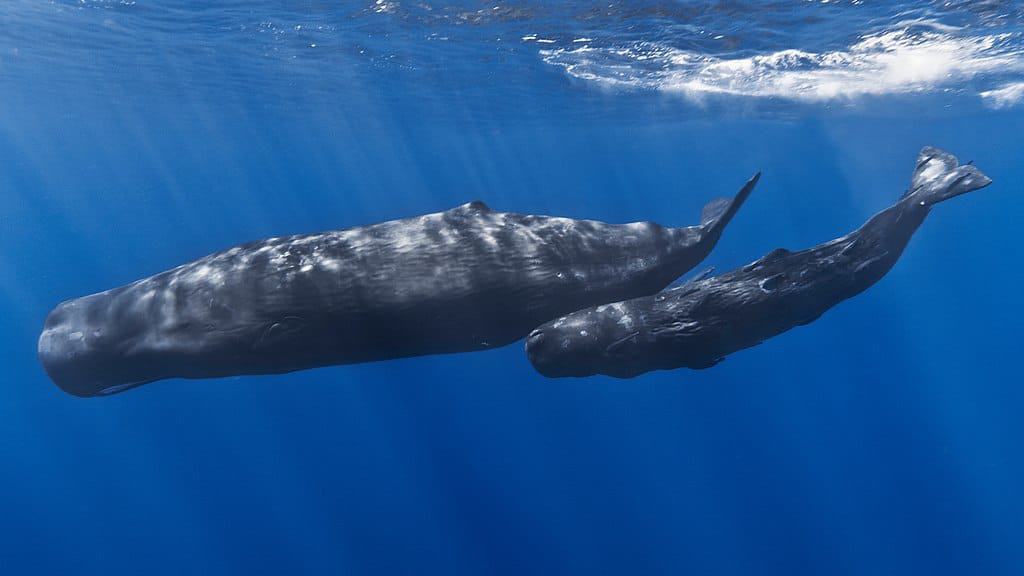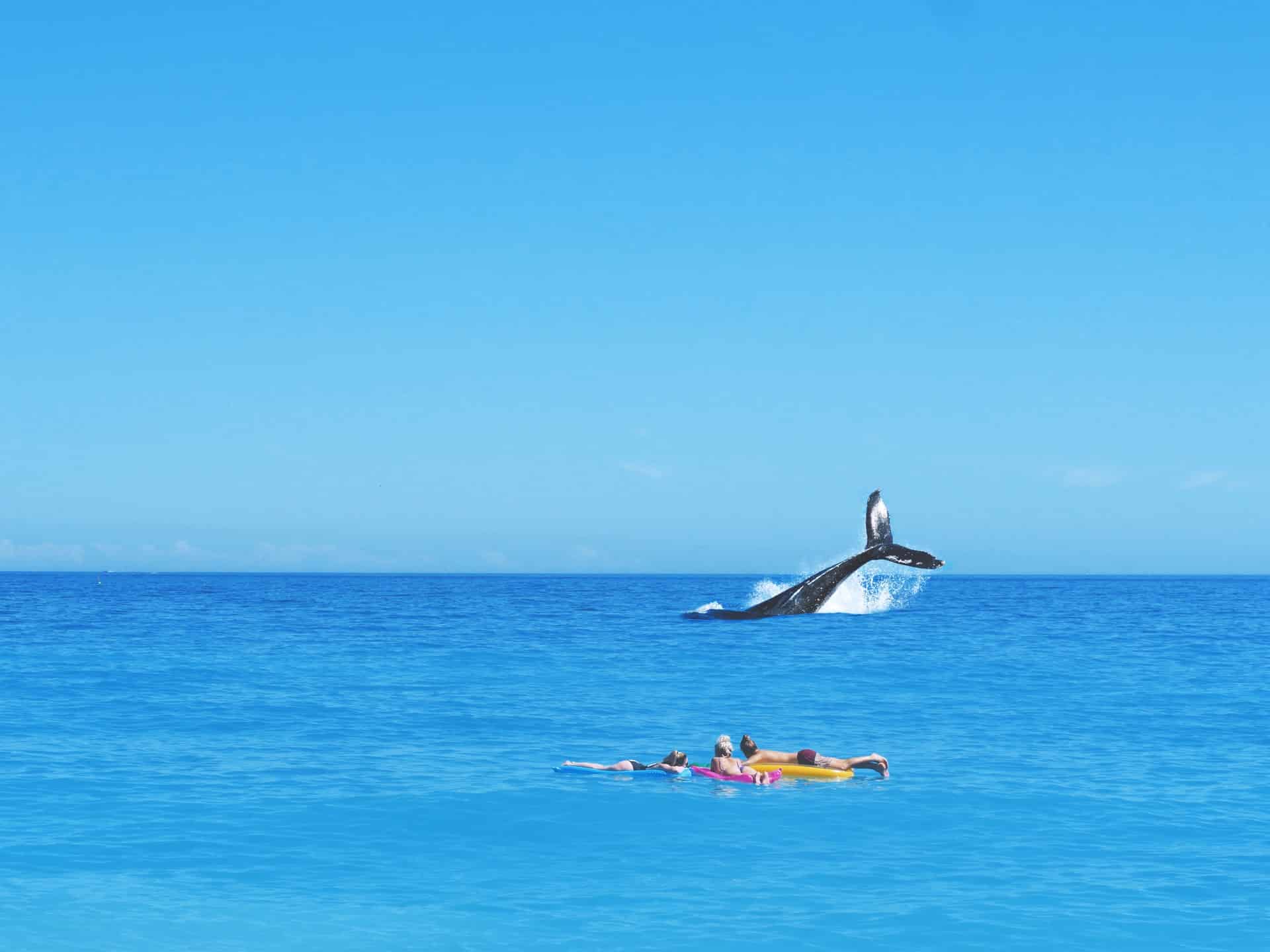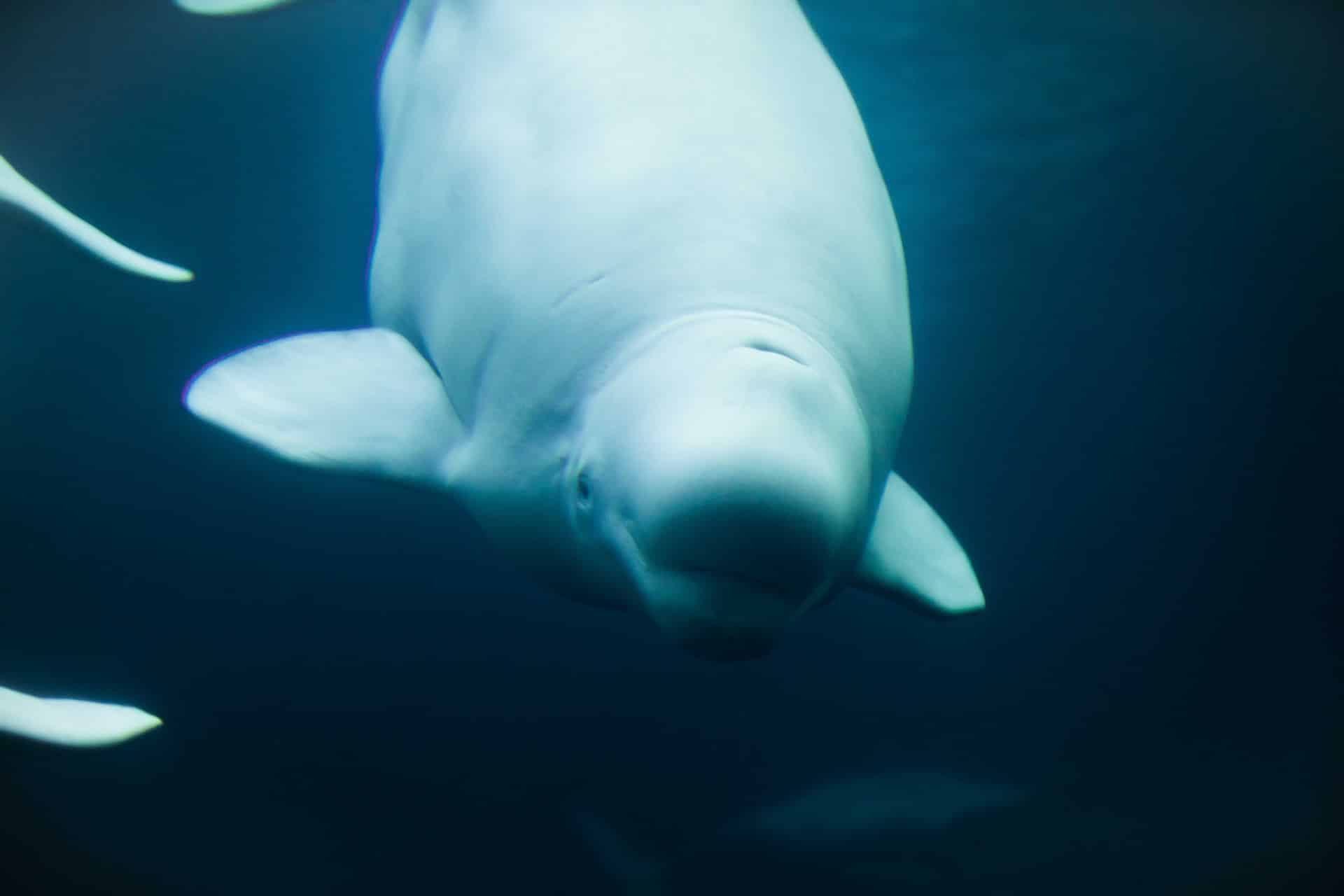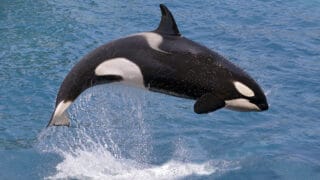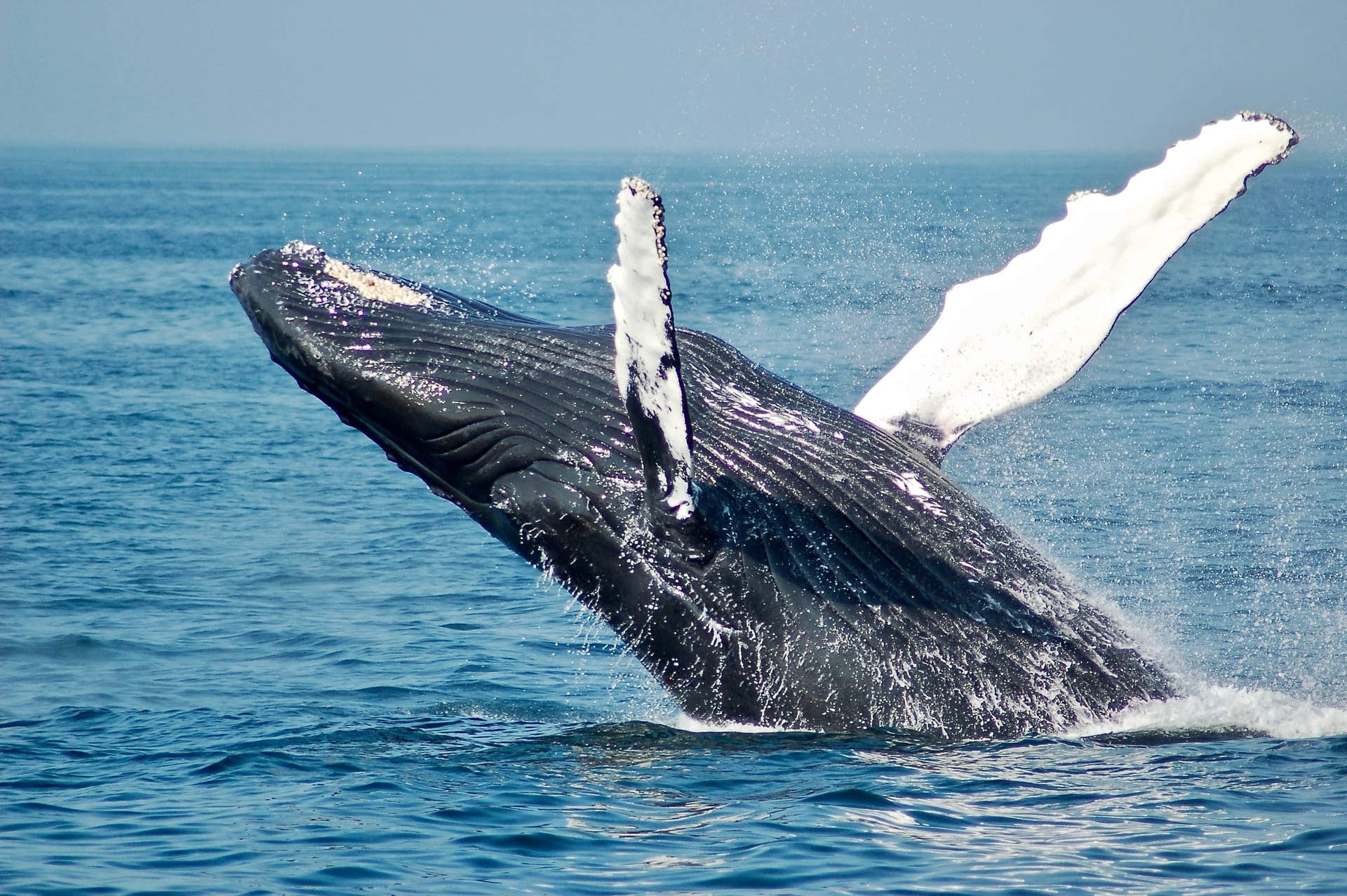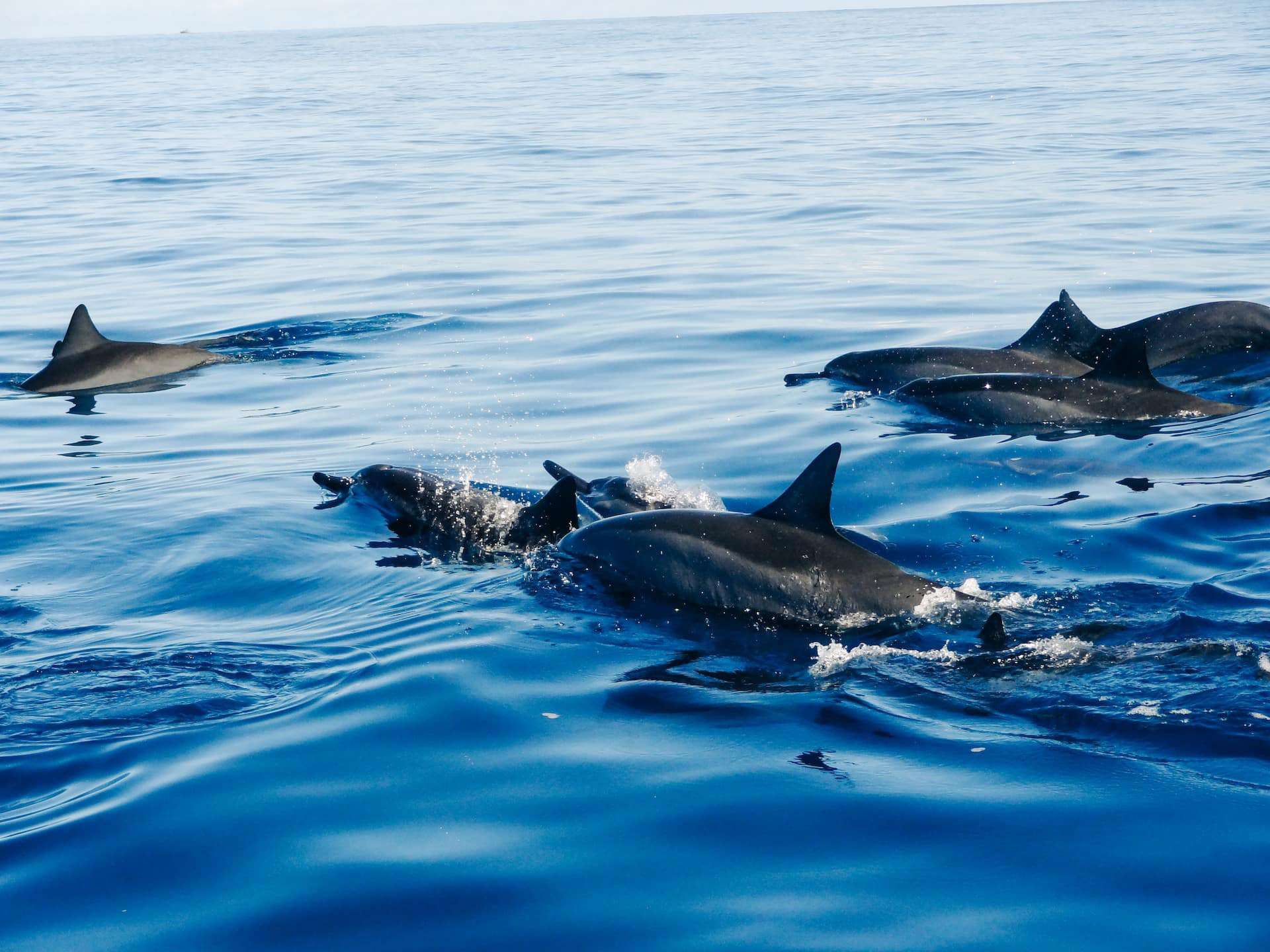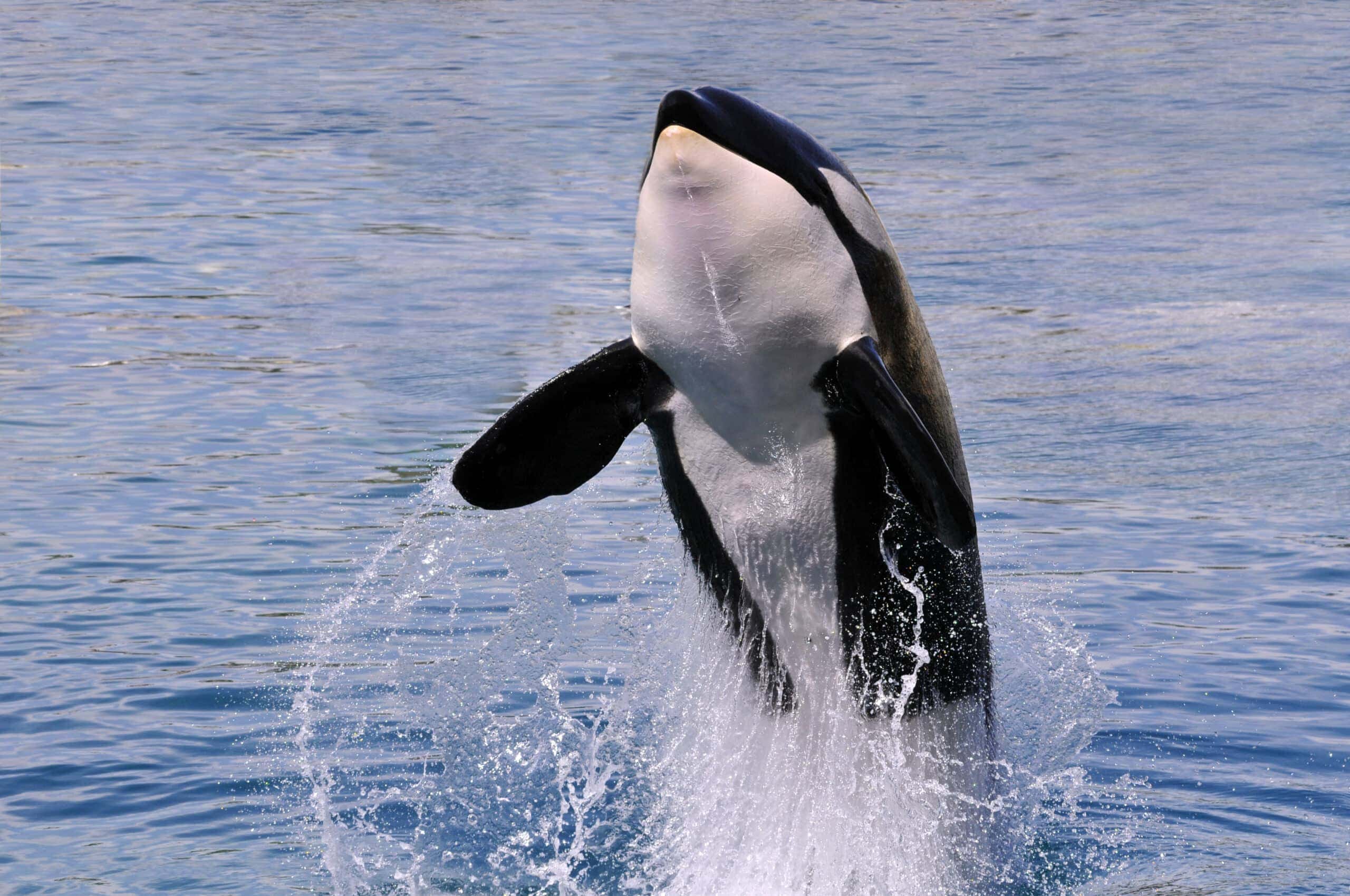Unveiling the Language of Whales – How Artificial Intelligence could make understanding these majestic creatures possible. The enigmatic world of whales has long fascinated humans. These majestic creatures, known for their complex social structures and hauntingly beautiful songs, have always left us with more questions than answers. But thanks to advances in artificial intelligence (AI), …
Whales
Welcome to All About Whales.
Whales are some of the few creatures in every corner of the globe. Different types roam through every sea and are beloved for many reasons- including how big and graceful they can be.

There are currently 90 known species of whales and dolphins living in the ocean, and roughly 25 000 individuals of all whale kinds were estimated in 2020.
Top Articles On Whales
- AI to Communicate With Whales?
- This Whale Sings in a Unique Pitch
- The Longest Blue Whale Ever Recorded
- The Largest Animal In The World
- Orca Lures Birds With Fish For A Sneaky Meal
- The Largest Whale Ever Caught on Camera
- The Mystical Pink River Dolphins of the Amazon
- Where to Watch Humpback Whales Breach During Migration
- The Deepest-Diving Mammal Holds Its Breath for Over Two Hours
- 13 Marine Mammals That Communicate Like Humans
- The Real Reason Orcas Are Called “Killer Whales”
- The Critically Endangered Maui Dolphin
- How Humpback Whales Create Bubble-Nets to Catch Fish
- Why Sri Lanka Is the Best Place to Spot Blue Whales
- The Silent Giant And Why the Whale Can Be Heard, But Not Seen
- Why the Dolphin is Considered a Spirit Animal of Joy and Freedom
- Why Dolphins are Known for Their Impeccable Hygiene
- Top 5 Places to See Fin Whales
- The Best States for Watching Humpback Whales Breach
- Why the Dugong is Disappearing from Our Oceans
- Exploring The World Of The Largest Sperm Whale
- The Best Places to See Blue Whales
- How the Whale Spirit Animal Connects You to Deep Intuition
- Where to See Gray Whales
- Best Places to Swim with Dolphins
- Beluga Whales
- Why Humpback Whales Sing in Accents
- Why Whale Songs Might Be Getting Louder
- 4 Best Places to Swim, Snorkel, or Dive with Orcas
- Humpback Whales
- Why Norway Is the Best Place to See Orcas in Their Natural Habitat
- The Truth About Dolphin Friendships Across Generations
- Could Whale Poop Actually Help Fight Climate Change?
- Where to see Sperm Whales
- The Walrus Booming Calls Sounds of the Arctic
- 15 Things You Didn’t Know About Whales
- Why the Blue Whale is the Loudest Animal in the Ocean
- The Most Stunning Whale Migration Off Alaska’s Coast
- Why the Manatee is One of the Slowest Marine Mammals
- Can We Save the Yangtze Finless Porpoise from Extinction?
- Why the World’s Loudest Animals Are Going Quiet
- Why the Vaquita is the World’s Most Endangered Marine Mammal
- How Dolphins Use Echolocation to Navigate and Hunt
- The Truth About Orca Intelligence Might Surprise You
- Scientists Are Using Whale Songs to Map the Ocean Floor
- 14 Tools Orcas Use to Outsmart Their Prey
- The Loudest Animal on Earth Meet the Sperm Whale
- 18 Powerful Lessons We Can Learn from Orca Social Structure
- 13 Coastal Spots Where You Might See Orcas in the Wild
- Could Whales Be the Planet’s Most Important Carbon Sinks?
- 12 Fun Facts About Dolphins You Didn’t Know
- 22 Orca Hunts You Have to See to Believe
- 17 Unique Whale Facts That Are Straight Out of a Science Fiction Novel
- Orcas Attacking Boats Off Spanish Coast Or Are We Attacking Orcas
- Why a Single Blue Whale Can Reshape an Entire Ecosystem
- 16 Fascinating Orca Hunting Techniques You Have Never Heard Of
- The Most Colossal Whale Ever Spotted Off Alaska
- What Happens If a Whale Dies in the Ocean?
- 12 Facts That Prove Orcas Are Apex Predators
- 15 Things Orcas Do That No Other Whale Can
- 10 Most Thrilling Places to Spot Whales in the U.S.
- Why Killer Whales Are Suddenly Attacking Boats
- 17 Astonishing Whale Behaviors That Will Leave You in Awe
- Why Humpback Whales Are Singing Louder Off U.S. Shores
- 14 Times Orcas Shocked Marine Biologists
- Orca Deadly Duo: Port and Starboard vs Great White Shark
- Whales Can Communicate Across Entire Oceans, and Scientists Just Discovered How
- The Deepest Whale Dive Ever Recorded Surprises Scientists
- Astonishing Orca Predation on Dolphins
- Scientists Found the Jawbone of a Whale Bigger Than Any Blue Whale
- The Most Gigantic Whale Ever Recorded And How Big It Was
- 12 Reasons Why Orcas Are More Dangerous Than Great White Sharks
- Swimming With a Pod Of Sperm Whales
- Witness the First Ever Documented Birth of a Sperm Whale
- Why More Whales Are Washing Up on Beaches—And What Scientists Are Learning From It
- Battle Between Economics and Conservation Heats Up For South Atlantic Whales
- Humpback Whale Breaches Out Front Of Seattles Space Needle
- The Largest Animal That Ever Lived—Bigger Than Any Dinosaur
- The Silent Giants: How Whales Communicate Across Oceans
- 60-Year-Old Orca Grandma Takes Down Great White Shark in Lightning Strike Captured on Video
- The Deepest-Diving Mammal in the World and How It Holds Its Breath for Hours
- World’s First Sperm Whale Reserve in Dominica
- North Atlantic Right Whales Face Imminent Extinction
- Alaska’s Oldest Animal is a Whale That Can Live 200 Years
- Why Beluga Whales Love to Mimic Human Voices
- The Largest Whale Ever Spotted Near the US
- 12 Rare Whale Sightings That Shocked Scientists in the US
- Exotic Massive Orcas Ambush Dolphins in Stunning Footage Captured Near San Diego
- The Largest Orca Ever To Be Spotted
- Citizen Scientists Capture Rare Bryde’s Whales Surfing in Australian Waters
- Huge Whale Crushes Small Fishing Boat
- How Killer Whales Pass Down Hunting Knowledge To Their Kids
- Meet Mãhina the All-White Humpback Whale Calf Making Waves in Tonga
- This Is What the Largest Whale in the World Can Do
- Are Whales Teaching Each Other to Avoid Ships?
- A Whale Migration Like No Other Is Happening Off the California Coast
- The Loudest Animal in the U.S. Isn’t What You Think
- These Whales Are Changing Migration Routes—Here’s Why
- The Deepest-Diving Whale Ever Tagged Was Found Near Hawaii
- Are Whales Trying to Communicate With Humans?
This blog will give an overview of a handful of the fantastic whales worldwide, which have more detailed blogs on Animals Around the Globe.
Humpback Whale
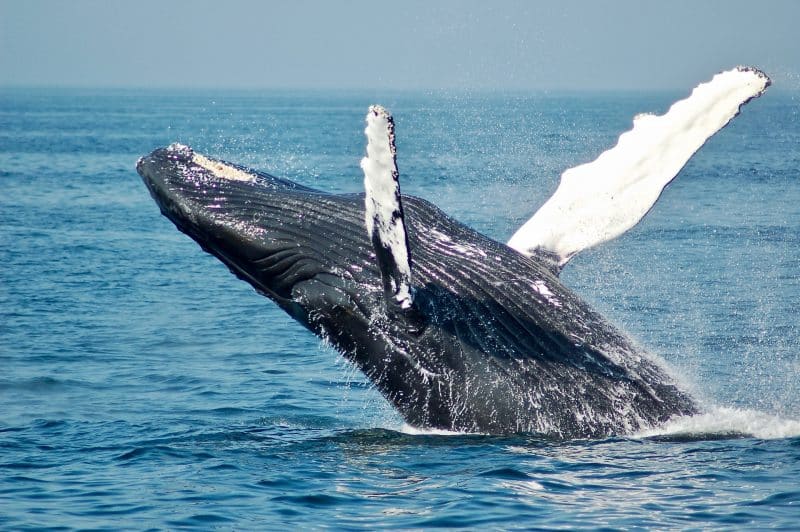
Humpback whales are large and beautiful; they’re common in all oceans around the globe and are considered very “playful” in nature. Humpback whales grow to be about 52 feet (16 m) long and weigh 30-50 tons (27-45 tonnes).
The females are slightly larger than males, as with all baleen whales. And the four-chambered heart of the average humpback weighs about 430 pounds (195 kg) – about as much as three average adult human beings.
Humpbacks come in 4 different color schemes, ranging from white to grey to black to mottled. There are distinctive patches of white on the underside of the flukes (tail). Humpbacks also have huge, mottled white flippers with rough edges up to one-third of their body length.
These markings are unique to each whale, like a fingerprint. And the humpback’s skin is frequently scarred and may have patches covered with barnacles.
Humpbacks have 14-35 throat grooves that run from the chin to the navel. These grooves allow their throat to expand during the vast water intake during filter feeding. They have small, round bumps on the front of the head (called knobs or tubercles), edging the jaws. The deeply-notched flukes (tail) are up to 12 feet (3.7 m) wide. Humpbacks have a small dorsal fin toward the flukes.
Humpback Whales are incredible to see in the wild… have a look at these operators below if you’re interested in seeing them for yourselves.
To see all places where you can see and swim with Humpback Whales, visit our guide to Humpback Whales.
Fin Whale
Fin Whales’ social structure can vary depending on where they are located. This may depend on the scarcity of food or age ranges. Fins have been observed solo, in pairs, and in pods of usually up to 6.
However, pods of much greater numbers, from 50 to 300, have also been seen. These larger pods are usually seen during migrations. The vocalizations of blue and fin whales are the animals’ lowest-frequency sounds.
Worldwide in tropical to polar latitudes. Fin whales are found in deep, offshore waters of all major oceans, primarily in temperate to polar latitudes. Read more on Best Places for Whale Watching and Sightings.
They are less common in the tropics. If lucky, one can view fin whales along most coastal stretches of the polar latitudes, depending on the right time of year. Cosmopolitan distribution if its range extends across all or most of the world in appropriate habitats. Such a taxon is said to exhibit cosmopolitanism or cosmopolitism.
Open ocean (pelagic); rarely coastal. Like other large whales, fin whales are thought to migrate between feeding and breeding grounds.
That said, resident populations do exist, and both the Gulf of California in Mexico and the Mediterranean are home to resident populations of fin whales. A great place to view fin whales in the Pelagos Sanctuary/ Mediterranean sea marine mammals protected area.
Full physical maturity is attained between 25 and 30 years. Fin whales have an average lifespan of about +/ – 90 years, although specimens have been found aged at an estimated 135–140 years
Mating occurs in temperate, low-latitude seas during the winter, followed by an 11- to 12-month gestation period. Females reproduce every 2 or 3 years with usually single births; Calves remain with their mothers for about one year
Have you ever wanted to see a fin whale in the wild? These tour operators can help you see this special creature on this mission.
To see all places where you can see and swim with Fin Whales, visit our Guide about Fin Whales.
Orca Whale
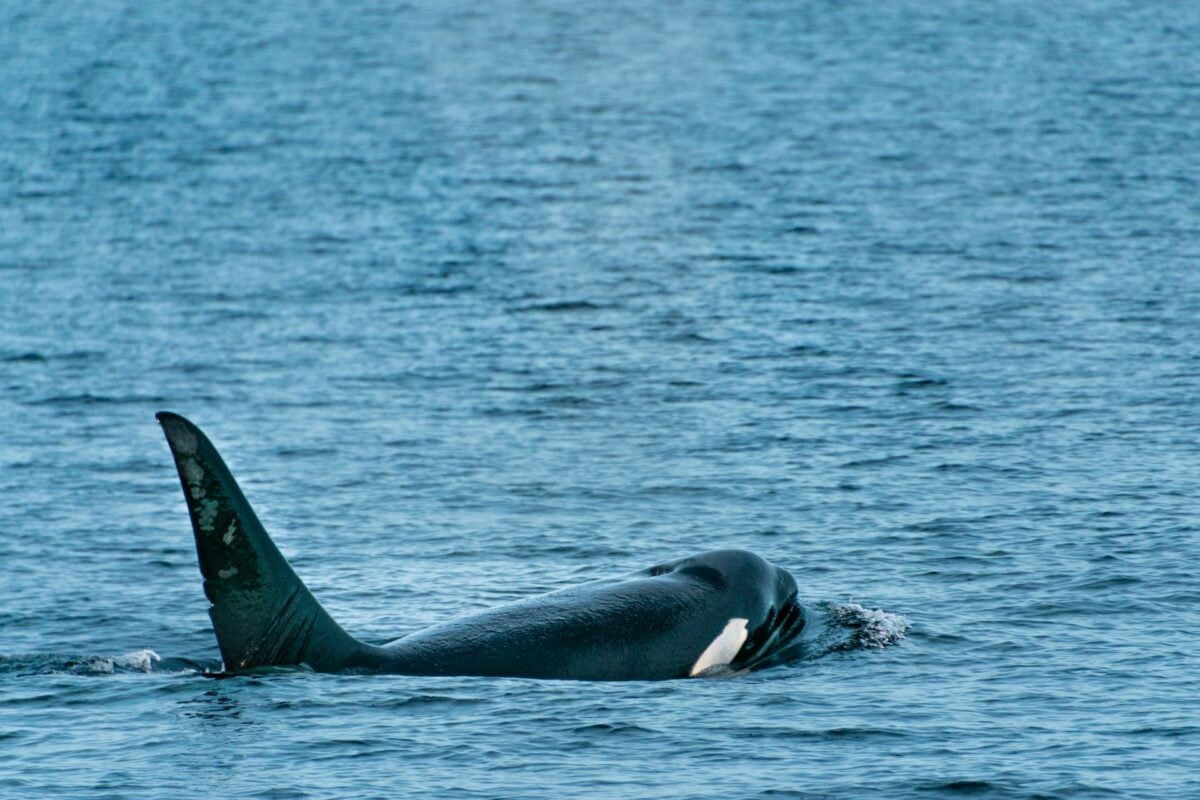
Did you ever wonder where do best places to swim or dive with Orcas are? We collected all the information you need to be ready for your orca expedition.
When you hear the word killer whale, you immediately imagine a vicious hunter in your head, fearsome and evil.
However, these animals are not what many people think. Get to know the beautiful and intelligent king of the sea, the Orca!
One of the best places to swim with Orcas is wintery northern Norway, where large quantities of herring gather.
Norway is an excellent destination for nature lovers all year round.
However, the best time to travel is between October and February if you want to watch the orcas at close range during their spectacular hunt. That’s when you also have an excellent chance to see the northern lights. Why not combine a trip?
Read all about Orca Whales here!
Blue Whale
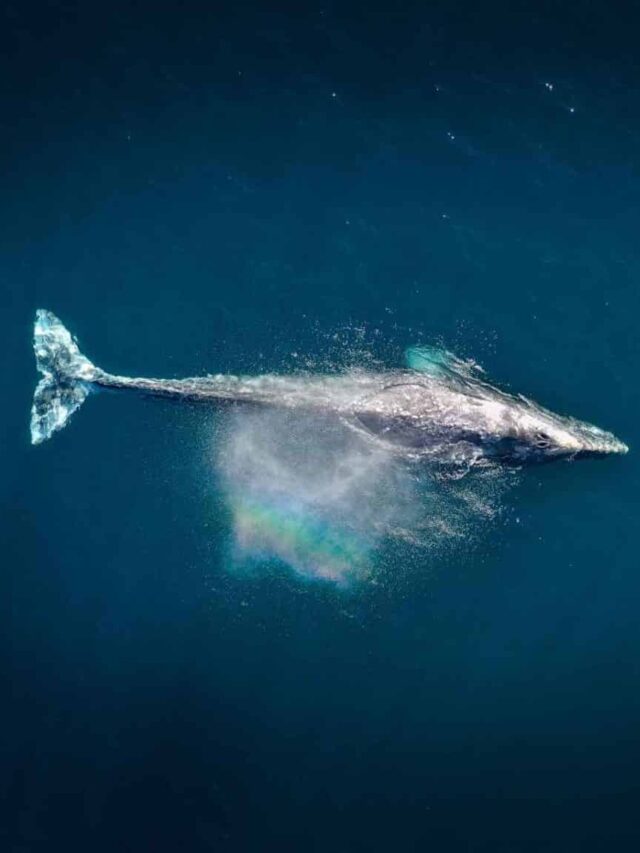
Blue whales are the largest animals on our planet in today’s modern times. They feed almost exclusively on krill, straining huge volumes of ocean water through their baleen plates (which hang from the roof of the mouth and work like a sieve). Some of the most prominent individuals may eat up to 6 tons of krill in 1 day.
Blue whales are also found in all oceans except the Arctic Ocean. Moreover, there are currently five identifiable and recognized subspecies of Blue whales around the globe.
Sadly, the number in the world’s oceans has sharply declined and is now only a tiny fraction of what it was (before modern commercial whaling significantly reduced their numbers during the early 1900s).
But, on a more encouraging note: populations are increasing globally. Blue whales are listed as endangered under the ‘Endangered Species Act’. The primary threats currently facing Blue Whales are vessel strikes and entanglements in fishing gear.
Fortunately, many global Fisheries and their partners are dedicated to conserving and rebuilding many whale populations worldwide. Many organizations use a variety of innovative techniques to study, protect, and rescue these endangered animals.
What is most effective is the engagement of our partners within the fishing industries to develop regulations and management plans that foster healthy fisheries and reduce the risk of entanglements, create whale-safe shipping practices, and reduce ocean noise.
This species of whales gain its name appropriately because they are simply a gorgeous blue color. Besides their fantastic color, their size is what is most impressive. Antarctic Blue Whales are generally larger than all other blue whale subspecies.
For example, in the North Atlantic and North Pacific, blue whales can grow up to about 90 feet, but in the Antarctic, they can reach up to about 110 feet and weigh more than 330,000 pounds. Like other baleen whales, female blue whales are generally larger than males.
Sighting the world’s most enormous whale is on the bucket list for many individuals; these two tour operators will gladly help you fulfill this desire. If interested, make use of the links below for more information.
To see all places where you can see and swim with Blue Whales, visit our complete Guide to Blue Whales.
Beluga Whale
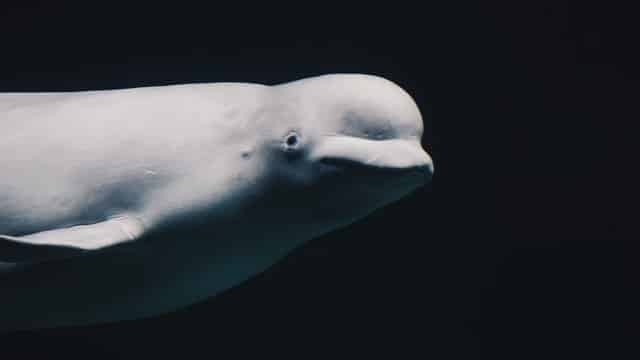
Beluga whales are dark grey as calves. Their skin lightens as they age, becoming white as they reach sexual maturity.
They lack a pronounced rostrum or beak, and the top of their head is characterized by a round, flexible “melon” that focuses and modulates their vocalizations, including echolocation “clicks.” They are toothed whales, possessing 36 to 40 teeth in both the upper and lower jawbones.
The genus name Delphinapterus translates to “dolphin without a fin.” Instead of a dorsal fin, belugas have a challenging dorsal ridge, allowing them to swim easily under ice floes (floating ice sheets). Look at the Best Places for Whale Watching and Sightings.
Unlike other whales and dolphins, their neck vertebrae are not fused, so belugas can nod and quickly move their heads from side to side.
Beluga whales are covered with a thick layer of blubber that accounts for up to 40 percent of their weight. The blubber keeps them warm in the Arctic waters and stores energy as they can go for extended periods with no food. Some beluga populations shed their outer layer of skin each summer during an annual molt.
They rub against coarse gravel in shallow waters to help remove the old, yellowed skin layer.
Belugas generally live together in small groups known as pods. They are social animals and are very vocal communicators that employ a diversified language of clicks, whistles, and clangs.
Belugas can also mimic a variety of other sounds that they hear. For example, considering the noise pollution that has come with increased cargo ships and boats in the water, they have also been noted trying to mimic these sounds. Follow more on Best Places for Whale Watching and Sightings.
Belugas produce sounds by building up air pressure in the nasal cavities within their melon ( the echolocation organ at the front of their heads) and forcing the air through a set of “phonic lips” atop each cavity. The vibrations of the lips result in the whale’s typical repertoire of echolocation clicks, pulse bursts, and chirp-like whistles and squeaks.
There are sad, many places you can see Beluga whales in captivity. These whales are subject to capturing and use for aquariums etc. Please avoid supporting any of these cruel facilities.
The tour operators below are for viewing these stunning animals in the wild!
To see all places where you can see and swim with Beluga Whales, visit our complete Guide to Beluga Whales.
Sperm Whales

The sperm whale’s huge brain and specialized sonar organ (called a melon) contribute to its characteristic block-shaped head.
It is the only whale with that shaped head and is typically quite easy to identify. The body is generally uniformly grey. And the sperm whale’s lifecycle is very similar to that of humans.
Sperm whale males reach sexual maturity around 18 years old and females at nine years old. Males battle for mating rights and then breed with multiple females. Male sperm whales do not create harems of females like other animals. The females reproduce until they reach their forties and live in their seventies.
The sperm whale pregnancy term lasts about 15 months, resulting in a single calf. Sperm whales give birth to only one calf at a time, and at birth, baby Sperm Whales are considerably large – over 13 feet (4 m) long.
The birth is always a social event, with the rest of the sperm whale pod forming a protective barrier around the birthing mother and her calf.
Because calves cannot undertake the deep, long dives that their mothers do, groups of mothers form tight bonds and share the responsibility of protecting calves at the surface. While one or more mothers dive, others stay at the surface with the young.
Whale sighting can be tricky and is never guaranteed by any tour provider. However, if you’re lucky, and the season and location are suitable for the year- you may get lucky and see these unique animals for yourself…
To see all places where you can see and swim with Sperm Whales, visit our Guide to Sperm Whales.
Gray Whales
https://www.pinterest.de/pin/579416308284166479
Gray Whales are large baleen whales. They are medium-sized whales, reaching up to 49 feet (15 m) in length, with the females usually being more significant than the males. They are gray with white patches, covered in barnacles and sea lice, animals that attach themselves to the whale.
They have been known to carry over 400 pounds of barnacles and whale lice on average. Gray whales have no dorsal fins. Instead, they have a ( Sometimes visibly) low hump. The size of a Gray whale compared to that of a human.
Bottom-feeding animals. Roll on the sides and suck up sediment whilst slowly swimming along the seafloor. During summer, feed in arctic waters for up to 20 hours. Read more on Best Places for Whale Watching and Sightings.
There are two geographic distributions of gray whales in the North Pacific: the eastern North Pacific stock, found along the west coast of North America, and the western North Pacific stock, found along the coast of eastern Asia.
Most of the eastern North Pacific stock gray whales spend the summer feeding in the northern Bering and Chukchi Seas. Some feed along the Pacific coast during the summer, in waters off of Southeast Alaska, British Columbia, Washington, Oregon, and northern California.
Where to see gray whales; The whales’ annual migration path
https://www.youtube.com/watch?v=MqRzdpd3tAs
North Atlantic populations were extinct on the European coast before AD 500, and on the American coast around the late 17th to early 18th centuries. Yet there have been recent sightings of whales along the Mediterranean sea, suggesting a repopulation in abandoned breeding grounds for centuries. In May and June 2013, a gray whale was sighted off the coast of Namibia – the first confirmed in the Southern Hemisphere.
The round-trip journey of one gray whale has set a new record for the longest mammal migration, covering a distance of more than 22,000 kilometers across the Pacific Ocean. This has indicated that new migration patterns may arise for these whales.
During summer, they live in the Arctic in areas rich in their food, bottom-dwelling organisms. As fall approaches, there is less sunlight and food, and the water turns cold.
This is when the whales travel to Baja, California, Mexico. Female gray whales usually give birth every two to three years. 5-12 years of sexual maturity. Gives birth to a single calf at 12-13 months. 7-8 months with calf.
Mothers and calves remain close to shore during the northward migration (usually within 200m of the coast), possibly trying and avoid killer whale attacks. Mothers are very protective, sometimes sacrificing their lives to predating killer whales to protect their calves.
The average and maximum lifespan of gray whales is unknown, although one female was estimated at to be 75 to 80 years old.
Gray whales are slower swimmers, so killer whales predate them. Gray whales are “devil fish” due to their aggressive nature encountering harpooning. endangered early 1900s harpoons. They usually Travel alone or in small groups besides feeding breeding grounds.
Would you like to experience a sighting of gray whales for yourself? The tour operators below can help you if you want to go on a whale-watching adventure!
To see all places where you can see and swim with Gray Whales, visit our Guide about Gray Whales.
Dolphins
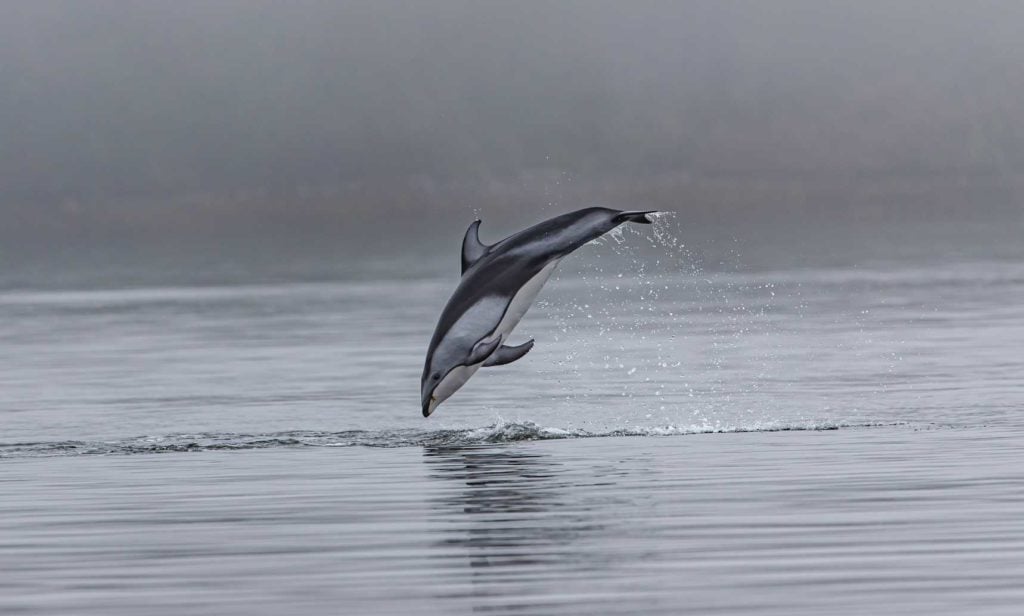
The largest species in the dolphin family, the killer whale, can reach more than 32.5 feet (10 meters) and weigh about ten metric tons (9,800 kilograms). However, most dolphins are much smaller.
For example, bottlenose dolphins reach an average length of 8–10 feet (2.5–3 meters) and weight of 300–650 pounds (135–300 kilograms). Likewise, the largest river dolphin, the Amazon river dolphin, can grow to about 9 feet (2.8 meters) and 350 pounds (160 kilograms).
One of the smaller dolphins, Hector’s dolphin, reaches about 4 feet (1.2 meters) long and weighs about 110 pounds (50 kilograms).
Dolphins have smooth, rubbery skin and are usually colored in black, white, and gray. They have two flippers, or fins, on their sides and a triangular fin on the back. Like other whales, they have an insulating layer of blubber (fat) beneath the skin.
Although they appear similar to porpoises, dolphins are distinguished from porpoises by their beaklike snout. Porpoises have short, blunt snouts. In addition, the teeth of dolphins are cone-shaped while those of porpoises are flatter.
The dolphin’s tail, which propels the animal in its lunges and dives, is horizontal rather than perpendicular to a fish’s tail. Dolphins are noted for being graceful swimmers, arcing through long, slow curves that bring the blowhole to the surface of the water and then expose the back fin as the animal dips downward.
At first glance, the high dorsal fin resembles a shark’s. Dolphins are also swift swimmers. The bottlenose can attain speeds of nearly 18 miles (30 kilometers) per hour in short bursts, and common dolphins are even faster. Several species are attracted by moving ships and often accompany them, leaping alongside and sometimes riding the waves created by the ships’ bows.
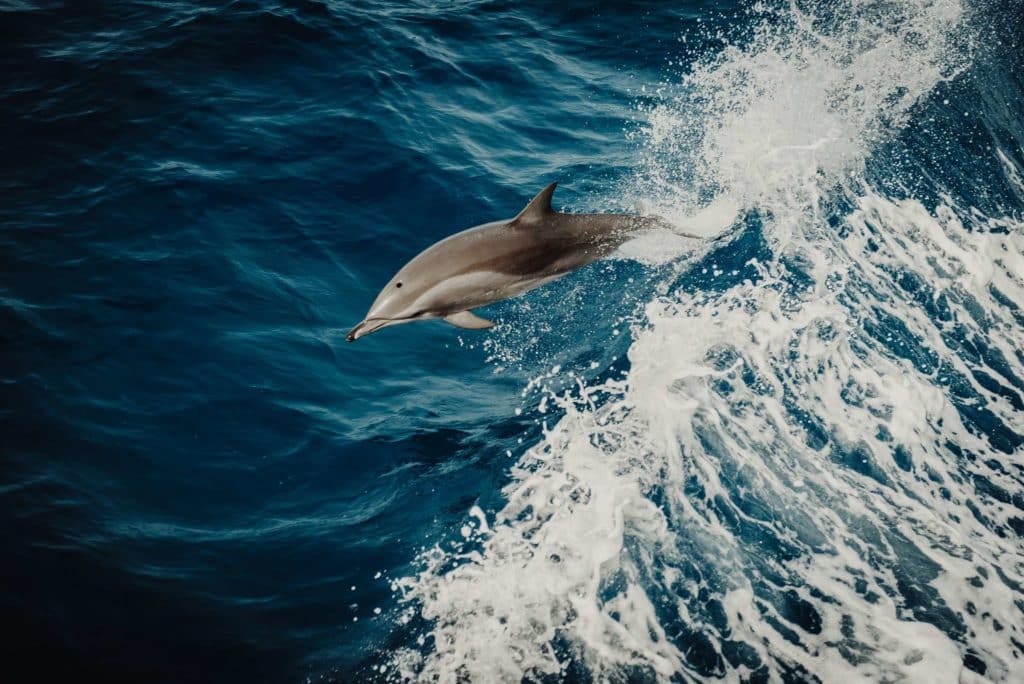
Dolphins are mammals, not fish, and are thus warm-blooded, keeping their body temperature constant even when exposed to different environmental temperatures. Like other whales, dolphins have lungs and breathe through a single nostril called the blowhole on top of the head.
Here is some excellent info on the Best Places for Whale Watching and Sightings.
Would you like to see a dolphin in the wild? Below are the names of some tour operators to see dolphins in the wild that we believe are significant.
To see all places you can see and swim with Dolphins, visit our complete Guide to swimming with Dolphins.
Why should we Protect Whales?
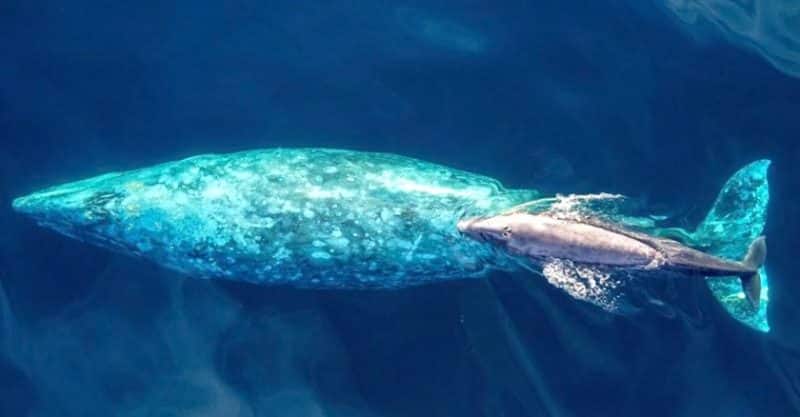
Whales are what is known as “keystone” species, having an essential role in the balance and healthy functioning of marine ecosystems, asserting a top-down control on the food chain and fertilizing our oceans, allowing the production of phytoplankton and the creation of more than 50% of the oxygen we breathe.
Through the movement of whales up and down the water column, zooplankton and fish are recirculated to surface waters in the form of nitrogen-rich fecal matter.
These nutrients are essential to the primary production of the marine ecosystem. They also fertilize the deep sea through “whale fall”, when a whale’s carcass sinks to the seafloor and provides nutrients to various scavengers.
Whales are indicators of ocean health; as top predators at the top of the marine food web, any change in their population status indicates changes in the ecosystem. Whales are cosmopolitan and found in all the world’s oceans, from the deep sea to coastal bays.
They also face threats of disturbance from tourist watching, but sustainable whale watching can significantly contribute to local coastal economies around the globe, thanks to people’s growing interest in whales. These animals are so important for ocean health yet some are still sadly at major risk of extinction.
What Threats Do They Face?

There are sad, many threats facing whales and other marine life today. To name a few:
Bycatch and Incidental Capture in fishing gear
Entanglement in fishing nets and gear, or ‘bycatch’, is currently the biggest threat facing dolphins, porpoises, and whales.
Entanglement refers explicitly to wrapping lines, netting, or other materials of anthropogenic origin around the body of animals. In contrast, bycatch refers to the unintentional capture of species such as small cetaceans in commercial fishing nets. Hundreds of thousands of individuals die due to drowning in fishing practices intended to catch commercially important fish species. It’s sad, pushed some whale species to the brink of extinction.
Ship Strike
Collisions between cetaceans and vessels – known as ‘ship strikes’ or ‘vessel strike’ – significantly cause death and traumatic injury. Tackling this threat to the world’s cetaceans is hampered by the fact that under- or non-reporting of ship strikes is still the norm around the globe.
Since 2009, more than 1,200 incidents have been reported to International Whaling Commission (IWC). Most reports of collisions between whales and vessels involve large whales, but all species can be affected. Collisions with large vessels often go unnoticed and unreported. Animals can be injured or killed and vessels can sustain damage.
Pollution
Plastics and toxins such as persistent organic pollutants (POPs) and endocrine-disrupting chemicals (EDCs) have been shown worldwide to impact the health of animals and other marine life.
Sadly, these toxin levels may be so high to hinder cetaceans’ reproduction and immune systems. Researchers initially believed that toothed animals, dolphins, and porpoises were at greater risk because they are higher on the food chain and, therefore, would be more prone to bioaccumulating toxins. However, current research shows that the baleens are also negatively impacted by toxins and pollutants in the sea.
Climate Change
Changes in meteorological and oceanographic variables leading to sea temperature increases in the polar regions threaten the ecology of many cetacean species on Arctic and Antarctic feeding grounds.
The narwhal, beluga and bowheads, found in the Arctic year-round, are in particularly affected and shifts in species ranges are evident with sightings of late of both beluga and bowheads in Irish waters and may be affecting migration patterns of large migratory species such as the Humpbacks.
Oil and Gas Industry
Three distinct threats are evident from human activities involving the oil and gas industry; habitat loss, and direct or indirect injury to cetaceans which can lead to temporary or permanent hearing loss or even mortality and pollution. Oil and gas exploration and extraction may cause disturbance to cetaceans in essential habitats for feeding, resting, and breeding. Seismic surveys in particular, have been shown to cause severe damage to cetaceans’ hearing.
In 1992, humpbacks off Newfoundland, Canada, were found stranded with damage to their inner ear structures following underwater blasting used in constructing oil installations. Seismic blasting by the oil industry in Alaska has also been found to damage the hearing of animals in the area. Toxins and pollutants released into the environment relating to the oil and gas industry also pose a severe health risk to cetaceans.
Habitat destruction

Destruction of critical habitat for cetaceans is directly linked to increasing human activity in the marine environment, from harbors, landfills, shipping channels, fisheries, and aquaculture, to recreational use of marine areas, including resort development and increased boat traffic.
All of the aforementioned anthropogenic activities can cause cetaceans to avoid important breeding and foraging areas or cause direct damage to the marine ecosystem.
Summary
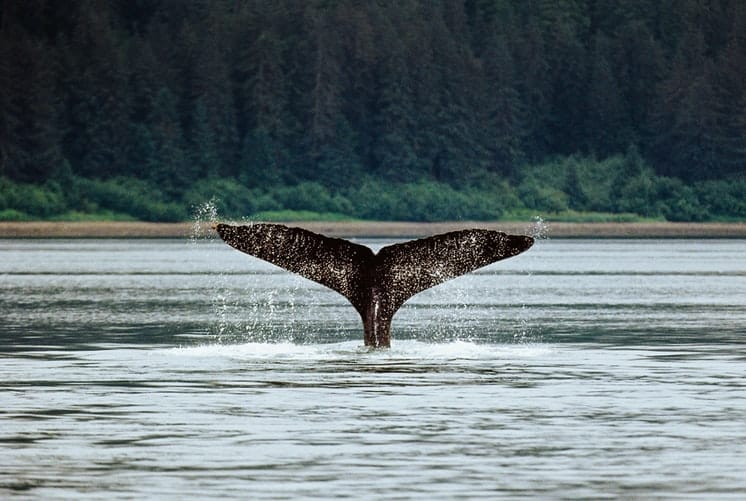
As is apparent, these animals are extraordinary animals with excellent characteristics and much that scientists are still to discover.
If you’re keen on finding these amazing animals in the wild and observing them in their natural habitat, consider the following tour companies we recommend to use as a tour operator.
If you want to swim with another fun mammal, look at our seal and sea lion article!
In the vast expanse of the world’s oceans, where sound travels farther than light, marine mammals have developed sophisticated vocal abilities to communicate across great distances. Among these ocean vocalists, one particular cetacean stands apart from its peers with an extraordinary vocal signature. The 52-Hertz Whale, often called “the loneliest whale in the world,” produces …
Let’s dive deeper into the longest Blue Whale ever measured! The blue whale, the largest animal on the planet, grows up to 100 feet long and weighs 200 tons. These magnificent creatures can be found throughout the world’s oceans and are essential to marine ecosystems. That is why they continue to fascinate and intrigue researchers …
Curious to meet the largest animal known to our planet? Just close your eyes and think of the largest animal in the world; it’s easy to think of an elephant or even a Dinasour, but when you give it some more thought you will realize, like we did, that the Earth’s biggest creature is not …
LATEST NEWS – Orca Lures Birds With Fish In the vast, mysterious oceans, orcas, known as killer whales, reign as apex predators. Renowned for their intelligence and strategic prowess, these magnificent creatures are the largest members of the dolphin family, boasting an impressive size of over 30 feet and weighing up to a staggering 12,000 …
Whales have long fascinated humans with their immense size, intelligence, and grace. Among these magnificent creatures, some stand out not just due to their enormity but also because they offer a window into the mysteries of our vast oceans. This article explores the incredible journey of the largest whale ever caught on camera, unraveling its …
In the deep, winding waterways of the Amazon Basin, a creature of almost mythical allure silently glides beneath the surface—the Amazon River dolphin, or “boto,” better known for its distinctive pink hue. Capturing the imaginations of locals and visitors alike, these dolphins represent an intriguing intersection of myth, science, and the unique ecosystems of the …
Witnessing a 40-ton humpback whale launch itself out of the ocean in a spectacular breach is one of nature’s most awe-inspiring sights. These magnificent marine mammals undertake some of the longest migrations of any animal on Earth, traveling thousands of miles between feeding and breeding grounds annually. During these journeys, humpbacks are known for their …
Deep beneath the frigid waters of the Southern Ocean, a remarkable marine mammal performs feats that defy our understanding of mammalian physiology. The Cuvier’s beaked whale (Ziphius cavirostris) is an extraordinary creature that has evolved to survive in one of Earth’s most extreme environments – the crushing depths of the ocean. These enigmatic cetaceans routinely …
The ocean depths harbor some of Earth’s most intelligent creatures, many with communication abilities that mirror our own in surprising ways. Marine mammals, having evolved in environments where sound travels efficiently, have developed sophisticated communication systems that parallel human language in complexity, intentionality, and function. From the haunting songs of humpback whales to the signature …
In the vast depths of our world’s oceans, few creatures command as much awe and intrigue as the orca. Known scientifically as Orcinus orca, these magnificent marine mammals have earned the dramatic moniker “killer whales” – a name that has shaped public perception for centuries. But what’s the real story behind this ominous nickname? Is …
The Maui dolphin, a subspecies of the Hector’s dolphin, is a marine wonder that is found exclusively in the coastal waters off the western shores of New Zealand’s North Island. Renowned for its playful nature and distinctive appearance, the Maui dolphin is a symbol of the region’s rich biodiversity. Unfortunately, this remarkable mammal is on …
In the vast blue expanse of our oceans, humpback whales have developed one of the most sophisticated hunting techniques ever observed in the animal kingdom. Bubble-net feeding represents the pinnacle of cetacean intelligence and cooperation, involving complex coordination and specialized roles among multiple whales. This remarkable strategy allows these massive marine mammals, which can reach …
Blue whales, the largest animals on the planet, are awe-inspiring creatures that capture the imagination of scientists, wildlife enthusiasts, and travelers alike. Measuring up to 100 feet in length and weighing as much as 200 tons, blue whales are a testament to the marvels of the natural world. Observing these gentle giants in their natural …
The ocean, vast and profound, is a world of mysteries and marvels. Among its most intriguing inhabitants is the whale, a creature that captivates the human imagination with its sheer size and enigmatic behavior. While these majestic giants of the sea are celebrated for their powerful and haunting calls, they are rarely seen in their …
The dolphin is a creature that has captivated human imagination and reverence for centuries. Known for their intelligence, agility, and social nature, dolphins are often considered spirit animals of joy and freedom. This perspective isn’t just a reflection of ancient folklore and mythology but is supported by modern animal science observations. By understanding the complexities …
Dolphins are among the most fascinating marine creatures, admired for their intelligence, social behavior, and playful nature. One aspect often overlooked is their impeccable hygiene. Unlike many other animals, dolphins exhibit behaviors that reflect an innate sense of cleanliness. This article explores why dolphins are renowned for their hygiene, delving into their cleaning habits, social …
The fin whale/ finback whale is the second-largest animal ever to live! Reaching lengths of at least 85 feet (26 m) and weights of 80 tons, this species is second only to its close relative, the blue whale. Their incredible size is only possible because of their aquatic lifestyles and the buoyancy provided by seawater. Following …
There are few wildlife spectacles as breathtaking as witnessing a 40-ton humpback whale launch itself out of the ocean, momentarily suspended in air before crashing back into the waves with a thunderous splash. This behavior, known as breaching, is one of nature’s most awe-inspiring displays and draws thousands of whale enthusiasts to coastal states across …
The dugong, often dubbed the “sea cow,” is a marine mammal that has roamed the warm coastal waters from East Africa to Australia for millions of years. It is closely related to the manatee, with both species belonging to the order Sirenia. Dugongs are unique for their fluked tails and down-turned snouts that are perfectly …
Get ready to explore the awe-inspiring world of the largest sperm whale in the world. These mighty creatures have long captured the imagination of scientists and nature enthusiasts alike with their legendary diving abilities and colossal size. Sperm whales can grow up to a massive 67 feet long and weigh over 50 tons, making them …
Looking for The Best Places to See Blue Whales? Then you are in the right place, meet one of the oceans Biggest inhabitants, and also, interestingly enough, the Loudest! Blue Whales are renowned for being the biggest mammals in the world, a big contrast to some of the worlds smallest mammals. They roam around the …
Whales have long been a source of fascination and wonder for humans. Their immense size, graceful movements, and mysterious behaviors in the deep oceans have inspired numerous myths, stories, and spiritual beliefs across various cultures. Among the many symbolic interpretations, the whale is often considered a powerful spirit animal that connects individuals to deep intuition. …
Looking for Where to see Gray Whales? Do you want to find out where to see Gray whales? We we have the perfect locations for you! You’ll be ready before the next whale watching season! The gray whale, also known as the grey whale, grayback whale, Pacific gray whale, or California gray whale, is a …
Are you looking for the best places to swim with dolphins? Imagine jumping into crystal clear water where smiling faces eager for the next fun adventure await you. They are curious about who you are and what to expect from you. Are you curious how they will react to you when you join them in …
Belugas whales, also known as white whales- because of their unusual bright white color- are among the most familiar and easily distinguishable whales in the Arctic. This color develops over time as calves are born grey or sometimes even brown and only fades into white as they become sexually mature around five years of age. …
The haunting melodies that travel through ocean depths have fascinated marine biologists and whale enthusiasts for decades. Humpback whales, known scientifically as *Megaptera novaeangliae*, produce some of the most complex vocal arrangements in the animal kingdom. But perhaps most intriguing is not just that these massive marine mammals sing, but that they do so with …
In the vast blue expanse of our oceans, a curious phenomenon has scientists puzzled and concerned: whale songs appear to be getting louder. These haunting, complex vocalizations that have captivated humans for decades are undergoing a transformation that may reveal significant insights about ocean health, whale behavior, and the impact of human activities on marine …
Diving with orcas, also known as killer whales, is one of the things on many wildlife enthusiasts’ bucket lists. When you hear the word killer whale, you immediately imagine a vicious hunter in your head, fearsome and evil. But there was never a recorded attack on a human being in the wild. Below, you can …
Humpback whales are famous for their beautiful, almost eerie songs, their incredible sizes, and their worldwide migration patterns. Introduction Humpback whales are distributed across all the world’s oceans. Their Latin name, Megaptera novaeangliae, translates to “big wing of New England,” referencing their large pectoral fins, which can reach up to 16 feet in length. This …
Norway is one of the premier destinations globally for observing orcas, also known as killer whales, in their natural habitat. The majestic coastal waters of this Scandinavian country provide the perfect environment for these apex predators. Whether you’re a nature enthusiast, a marine biologist, or simply an adventure-seeker, witnessing orcas in Norway offers an unforgettable …
In the vast blue expanse of our oceans, dolphins navigate not just currents and tides, but complex social networks that span decades and generations. These intelligent marine mammals have long fascinated researchers and ocean enthusiasts alike with their apparent capacity for forming meaningful social bonds. Unlike many species whose social connections are primarily driven by …
When it comes to fighting climate change, most people think about planting trees, installing solar panels, or switching to electric vehicles. Few would ever consider whale excrement as part of the solution. Yet, in recent years, scientists have been exploring an unexpected ally in the battle against rising carbon dioxide levels: whale poop. This seemingly …
Sperm Whales are some of the largest animals in the oceans. If you have ever wondered ‘Where to see Sperm Whales?’, then you are at the right place! Easily identified for their striking large block-shaped forehead, sperm whales are truly one of the most majestic creatures in the sea. Highly sought after in the mid-1800s …
The walrus, with its distinctive ivory tusks, wrinkled brown skin, and sizable body, is a fascinating marine mammal that resides primarily in the Arctic region. Known scientifically as Odobenus rosmarus, walruses are members of the pinniped family, which also includes seals and sea lions. Found in the frigid northern waters of the Atlantic and Pacific …
Imagine standing on the deck of a ship, feeling the salty spray on your face, when suddenly a massive shadow rises from the deep blue ocean. It’s a whale—majestic, mysterious, and utterly captivating. Whales have lived on this planet for millions of years, yet most of us only know the basics: they’re big, they live …
The ocean is a place of mystery and wonder, teeming with life forms that have adapted to its depths in extraordinary ways. Among these marvels is the blue whale, a gentle giant considered the loudest animal in the ocean. Known for their incredible size, blue whales also boast an impressive auditory capability that enables them …
Whale migrations have long captured the human imagination with their profound sense of mystery and grandeur. Among these great journeys, the migration off Alaska’s coast is particularly stunning due to its scale, spectacle, and scientific importance. This article delves into the captivating details of this marine phenomenon, offering insights into the majestic creatures making these …
The manatee, often affectionately referred to as a “sea cow,” is a gentle giant roaming the warm waters of the coastlines of the Americas and Africa. These peaceful marine mammals belong to the order Sirenia, which also includes the dugong. Manatees have charmed people with their large, whiskered faces and slow-moving demeanor. However, unlike many …
The Yangtze finless porpoise is a remarkable yet critically endangered marine mammal inhabiting China’s longest river, the Yangtze. Known for its strikingly intelligent nature and perpetual smile, this species symbolically showcases the challenges faced by aquatic wildlife amid rapid industrialization and environmental degradation. Once abundant, the finless porpoise is now fighting a battle against extinction. …
In the symphony of nature, some of Earth’s creatures have evolved remarkable abilities to produce sounds of extraordinary volume. From the thunderous rumble of whales communicating across ocean basins to the deafening chirps of tiny insects, these acoustic marvels have long fascinated scientists and nature enthusiasts alike. Yet, in recent decades, researchers have observed a …
Among the many creatures that inhabit our vast oceans, the Vaquita is a particularly intriguing and endangered marine mammal. Found only in the northern part of the Gulf of California, Mexico, the Vaquita is a small porpoise with a unique appearance and an astonishingly low population, making it the world’s most endangered marine mammal. This …
Do you know how dolphins use echolocation to navigate and hunt? Let’s find out. Echolocation is a fascinating biological phenomenon that allows certain animals to use sound waves to navigate their environment. This remarkable ability has evolved in numerous species, including some marine mammals, that depend on it for survival. Dolphins are fascinating marine mammals, …
The majestic black and white predators that patrol our planet’s oceans have captivated human imagination for centuries. Known as killer whales or orcas, these apex predators possess a fearsome reputation as skilled hunters. But beneath their imposing appearance lies something even more remarkable: an intelligence so sophisticated and multifaceted that scientists are still uncovering its …
In the vast, unexplored depths of our oceans, a revolutionary scientific approach is emerging that combines marine biology with geology in an unexpected way. Scientists have begun harnessing the powerful, low-frequency songs of whales to map the ocean floor—a technique that promises to transform our understanding of underwater topography while minimizing human impact on marine …
Killer whales, or orcas (Orcinus orca), stand as the ocean’s apex predators, showcasing remarkable hunting prowess across the world’s seas. These intelligent marine mammals have developed sophisticated strategies and tools that allow them to outmaneuver, outsmart, and capture prey in various environments. From coordinated hunting techniques to advanced communication systems, orcas demonstrate problem-solving abilities that …
The sperm whale, scientifically known as Physeter macrocephalus, is not only the largest of the toothed whales but also holds the remarkable distinction of being the loudest animal on Earth. These magnificent creatures have long fascinated both scientists and enthusiasts alike, thanks to their impressive vocalizations, which play a crucial role in their daily lives. …
Orcas, also known as killer whales, are one of the most intelligent and socially complex animals in the ocean. Despite their name, these marine mammals are known for their highly developed social structures, making them fascinating subjects for study. In this article, we will explore 18 powerful lessons that we can learn from the social …
Orcas, also known as killer whales, are among the most majestic and intelligent marine mammals on our planet. These apex predators are found in oceans worldwide, but certain coastal regions offer particularly good opportunities for witnessing them in their natural habitat. From the frigid waters of Antarctica to the temperate coasts of North America and …
In the vast blue expanse of our oceans, Earth’s largest inhabitants quietly perform an ecological service that may be crucial to our planet’s climate stability. Whales, with their enormous bodies and complex lifecycles, are increasingly recognized not just as magnificent marine mammals but as significant contributors to carbon sequestration. As climate scientists search for solutions …

